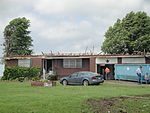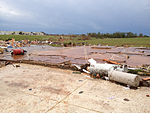Enhanced Fujita scale
The Enhanced Fujita scale is a tornado category scale used to measure tornadoes in the United States and Canada, and some other countries by how bad their damage is. It is a replacement of the old Fujita scale that was made in 1971. The National Weather Service started using it on February 1, 2007 and Canada started in April 2013. More countries have used it since then. The weakest tornadoes on this scale are rated EF0, and the strongest ones are rated EF5. Tornadoes with the EF5 label represent winds faster than 200 miles an hour. No tornadoes in the United States that happened before February 1, 2007 will have their ratings changed to the new scale.
| Scale | Wind speed (Estimated)[1] |
Example of damage | ||
| mph | km/h | |||
| EFU | Unknown | Unknown | No damage
Short for "EF-Unknown." The tornado doesn't hit anything, so there is no damage to tell how strong it is, or nobody can get to the damage to rate it.[2] |
N/A |
| EF0 | 65–85 | 104–137 | Small damage.
Some damage to chimneys; branches broken off trees; sign boards damaged; some singles blown off. |

|
| EF1 | 86–110 | 138–177 | Medium damage.
Badly peels surface off roofs; mobile homes pushed or rolled over; moving cars and trucks pushed off the roads; garages may be destroyed. |

|
| EF2 | 111–135 | 178–217 | Fairly bad damage.
Roofs come off frame houses; mobile homes destroyed; big trees snapped or uprooted. |

|
| EF3 | 136–165 | 218–266 | Bad damage.
Roofs and some walls come off well-made houses; trains rolled over; most trees in forest uprooted; skyscrapers twisted and messed up; heavy cars lifted off the ground and thrown. |

|
| EF4 | 166–200 | 267–322 | Very bad damage.
Well-made houses leveled; buildings and other things with weak foundations blown away very far; skyscrapers and highrises destroyed. |

|
| EF5 | >200 | >322 | Worst damage.
Strong frame houses lifted off foundations and thrown very far away which are soon destroyed; trees debarked; strong steel concrete structures badly damaged. |

|
References
change- ↑ "Enhanced F Scale for Tornado Damage". Storm Prediction Center. Retrieved 2009-06-21.
- ↑ Murphy, John D. (30 August 2020). "National Weather Service Instruction 10-1605" (PDF). National Weather Service. pp. A–74–75. Retrieved 29 November 2019.